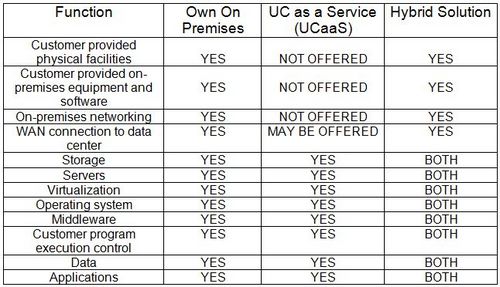
Unified Communication (UC) in the cloud is a favorite subject of many papers, webinars, podcasts, press releases, and articles. The hype is not wrong, but it often leaves out the reasons to stay with an on-premises system and it inflates the reasons to use a cloud-based UC solution. Some organizations have opted for a hybrid solution using a mix of cloud and premises-based platforms. However, some businesses are reluctant to adopt a cloud service because they worry about control and security.
The Past Moves to the Present
For decades, the approach for supporting communications for most organizations has been to purchase and operate a system on their premises. A few went with a CENTREX service. The on-premises system continues to be common even with the advent of competing UC cloud services. Those operating and maintaining on-premises systems have the years of operational knowledge and experience because the traditional PBX was designed to last many years; some have operated successfully for two decades.
Why Organizations Want Premise-Based Systems
The business that wants to have an on-premises system usually has one or more reasons for continuing with the on-premises solution.
- The business is capital intensive so an OPEX approach (like cloud UC service) does not fit into its financial approach.
- The business already owns an on-premises system and is satisfied that it meets their UC requirements.
- UC is mission critical and the business cannot justify moving to the cloud even when it may be less expensive.
- The on-premises system is covered by contracts that will not expire soon and contract termination is not negotiable.
- Signing a cloud contract can create provider lock-in which the business wants to avoid.
- The custom features may be required that are not offered by the cloud service.
- The compliance, regulatory, and security requirements of the business do not allow outsourcing to a cloud provider.
- The cloud Service Level Agreement (SLA) does not satisfy the business availability/reliability requirements; e.g. 99.9% availability is not good enough.
- The financial credits offered by the cloud provider do not offer any substantial monetary payment to offset the cost of an outage.
- The business has significant seasonal traffic fluctuations where the cloud contract cannot be easily reduced without financial penalties.
- There may be no SLA covering the voice quality since some voice providers route voice calls voice calls over the Internet or do not control the access link.
- Those operating and maintaining the on-premises system are unionized and the business cannot negotiate a change to those employees' status.
The Hybrid Approach
A growing approach combines on-premises and cloud solutions. A hybrid solution eliminates the isolation and provider borders. Existing UC services from the on-premises system can be augmented with UC cloud services that are not supported by the on-premises system. For example, the enterprise may seek to only offer extended UC cloud services to particular persons or departments and without upgrading the on-premises system. As can be seen by the table below, the hybrid solution has many duplicate components based on-premises and the cloud.
The hybrid solution allows the enterprise to maximize the features that are mandatory for the entire organization, while using cloud based features for those in the organization that need them. With the combination of current on-premises technology and cloud, the expense of procuring new on-premises features for departments that do not need them is eliminated.
The enterprise can always move functions from the cloud to a full premises-based system if the cost of cloud service begins to exceed the cost of on-site implementation. The hybrid approach can also deliver business continuity failover services at a much lower cost. The enterprise does not have to have a new or expanded on-premises backup system; rather, all of these functions can be moved to the cloud when there is an on-premises system failure.
Making the Decision: Security and Control
There are multiple reasons to adopt any of the three UC approaches listed above. One of the most common reasons for not adopting a cloud service is security. This is especially true for regulated vertical markets like healthcare, financial services, and some government operations. Organizations that own their IT equipment typically feel more secure than if the responsibility for security was under the control of a third party. However, regardless of approach, the enterprise is still the final responsible party when it comes to security.
Another common decision-making factor when choosing IT equipment is control. If the enterprise looks at UCaaS as the best communications solution, then it means that they are willing to place most of the control into the hands of the service provider.
A third common concern is provider lock-in. Once the business changes its IT staff to support cloud services, it is a considerable effort to return those cloud-based services back into an on-premises solution/network. Often, hybrid solutions allow the business to select what functions to implement in the cloud and what to retain on-premises balancing cost, control, and security. The hybrid solution has the most flexibility.
Conclusions
All businesses should look at cloud services though, even if the final decision is not to use them. If a cloud service looks attractive, then the enterprise should consider the least mission critical functions as candidates for the cloud. If the cloud is not successful, the impact of moving out of the cloud will be minimal. Still, for all the hype about the UC cloud, organizations still have plenty of good reasons to stick with an on-premise solution.














I am surprised that you did not mention the options for "private" vs. "public" cloud implementations. That is where an organization can control cloud apps that are for internal users only vs. those for business partners and customers/consumers.
While some of those arguments are temporarily valid, they will NOT last forever.